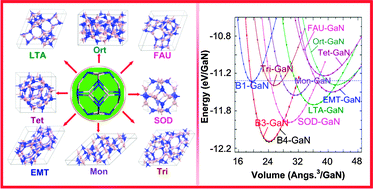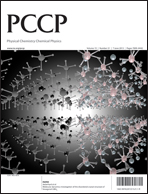Low-density nanoporous phases of group-III nitrides built from sodalite cage clusters†
Abstract
We report a new family of M12N12 (M = Al and Ga) cluster-assembled low-density materials with distinguished structures and properties based on state-of-the-art first-principles calculations. Specifically, the thermodynamic stability of the sodalite cage M12N12, with Th symmetry and a large HOMO–LUMO gap, is firstly proved using a first-principles molecular dynamics (FPMD) study. We consider this novel structure as a building block to construct new cluster-assembled materials. On the basis of the interaction of the cages with each other, eight new low-density nanoporous phases have been characterized, some of which with high stability are even more stable than experimentally synthesized MN phases. The intrinsic higher flexibilities (lower bulk moduli) and porous characteristics (the pore size: from 0.360 to 0.952 nm for AlN, 0.381 to 0.982 nm for GaN) of these phases should make them extremely promising for molecular sieving, gas storage, and particularly, atomic transport, control and purification applications. Furthermore, these new materials can not only retain the structural characteristics of the building block, but also preserve its electronic properties of wide-energy gap, with an indirect or a direct band gap of 1.038–2.640 eV. Our results may be feasible for extending the range of properties and applications of the corresponding MN compound.


 Please wait while we load your content...
Please wait while we load your content...